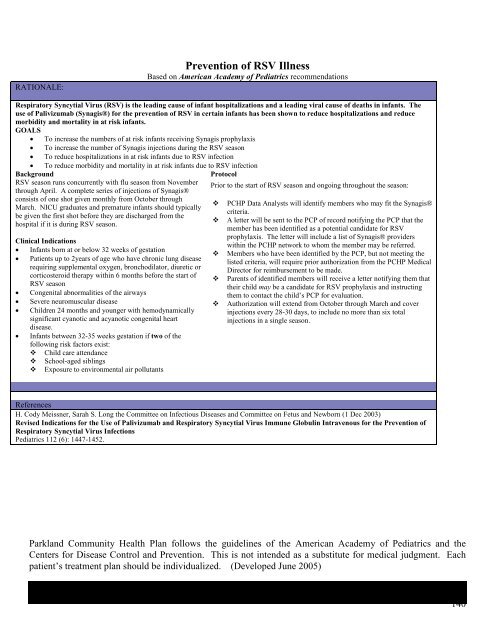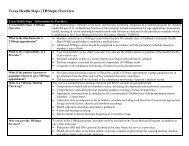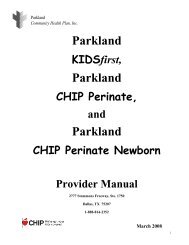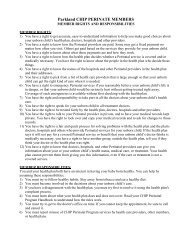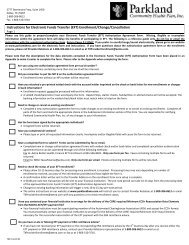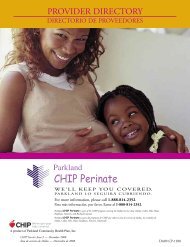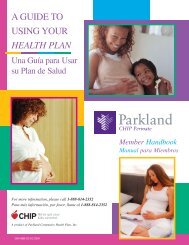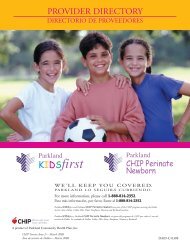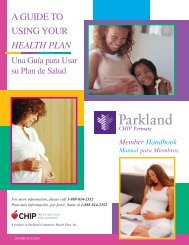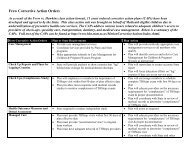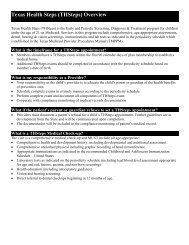PARKLAND HEALTHfirst - Parkland Community Health Plan, Inc.
PARKLAND HEALTHfirst - Parkland Community Health Plan, Inc.
PARKLAND HEALTHfirst - Parkland Community Health Plan, Inc.
Create successful ePaper yourself
Turn your PDF publications into a flip-book with our unique Google optimized e-Paper software.
RATIONALE:<br />
Prevention of RSV Illness<br />
Based on American Academy of Pediatrics recommendations<br />
Respiratory Syncytial Virus (RSV) is the leading cause of infant hospitalizations and a leading viral cause of deaths in infants. The<br />
use of Palivizumab (Synagis®) for the prevention of RSV in certain infants has been shown to reduce hospitalizations and reduce<br />
morbidity and mortality in at risk infants.<br />
GOALS<br />
• To increase the numbers of at risk infants receiving Synagis prophylaxis<br />
• To increase the number of Synagis injections during the RSV season<br />
• To reduce hospitalizations in at risk infants due to RSV infection<br />
• To reduce morbidity and mortality in at risk infants due to RSV infection<br />
Background<br />
RSV season runs concurrently with flu season from November<br />
through April. A complete series of injections of Synagis®<br />
consists of one shot given monthly from October through<br />
March. NICU graduates and premature infants should typically<br />
be given the first shot before they are discharged from the<br />
hospital if it is during RSV season.<br />
Clinical Indications<br />
• Infants born at or below 32 weeks of gestation<br />
• Patients up to 2years of age who have chronic lung disease<br />
requiring supplemental oxygen, bronchodilator, diuretic or<br />
corticosteroid therapy within 6 months before the start of<br />
RSV season<br />
• Congenital abnormalities of the airways<br />
• Severe neuromuscular disease<br />
• Children 24 months and younger with hemodynamically<br />
significant cyanotic and acyanotic congenital heart<br />
disease.<br />
• Infants between 32-35 weeks gestation if two of the<br />
following risk factors exist:<br />
Child care attendance<br />
School-aged siblings<br />
Exposure to environmental air pollutants<br />
Protocol<br />
Prior to the start of RSV season and ongoing throughout the season:<br />
<br />
<br />
<br />
<br />
<br />
PCHP Data Analysts will identify members who may fit the Synagis®<br />
criteria.<br />
A letter will be sent to the PCP of record notifying the PCP that the<br />
member has been identified as a potential candidate for RSV<br />
prophylaxis. The letter will include a list of Synagis® providers<br />
within the PCHP network to whom the member may be referred.<br />
Members who have been identified by the PCP, but not meeting the<br />
listed criteria, will require prior authorization from the PCHP Medical<br />
Director for reimbursement to be made.<br />
Parents of identified members will receive a letter notifying them that<br />
their child may be a candidate for RSV prophylaxis and instructing<br />
them to contact the child’s PCP for evaluation.<br />
Authorization will extend from October through March and cover<br />
injections every 28-30 days, to include no more than six total<br />
injections in a single season.<br />
References<br />
H. Cody Meissner, Sarah S. Long the Committee on Infectious Diseases and Committee on Fetus and Newborn (1 Dec 2003)<br />
Revised Indications for the Use of Palivizumab and Respiratory Syncytial Virus Immune Globulin Intravenous for the Prevention of<br />
Respiratory Syncytial Virus Infections<br />
Pediatrics 112 (6): 1447-1452.<br />
<strong>Parkland</strong> <strong>Community</strong> <strong>Health</strong> <strong>Plan</strong> follows the guidelines of the American Academy of Pediatrics and the<br />
Centers for Disease Control and Prevention. This is not intended as a substitute for medical judgment. Each<br />
patient’s treatment plan should be individualized. (Developed June 2005)<br />
140


